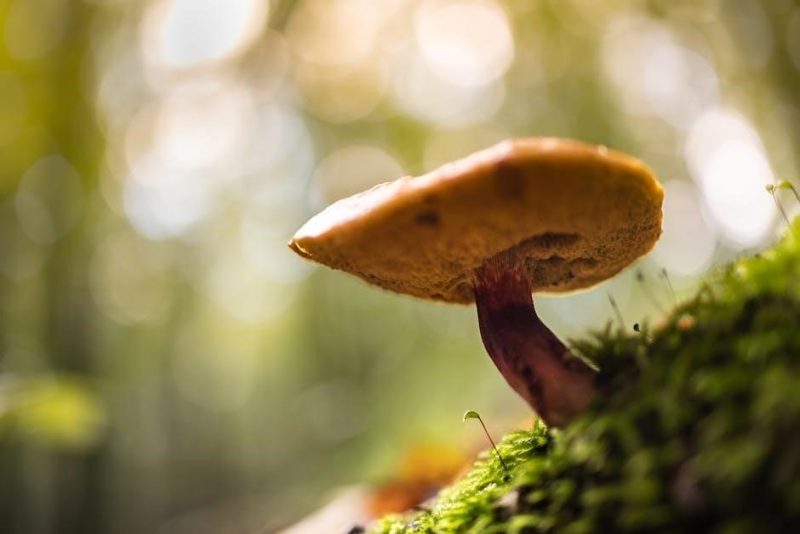psilocybin magic mushroom grower’s guide
Discover the ultimate guide to growing psilocybin mushrooms. Learn expert tips, techniques, and everything you need to know for a successful harvest.
Cultivating psilocybin mushrooms offers a rewarding journey into mycology, blending science and nature. This guide provides a comprehensive overview, ensuring a successful and safe growing experience for enthusiasts.
1.1 Importance of Understanding the Basics
Mastering the fundamentals of psilocybin mushroom cultivation is crucial for success. Understanding the life cycle, substrate preparation, and environmental requirements ensures a healthy grow. Neglecting these basics can lead to contamination or poor yields. A strong foundation in mycology and sterile techniques is essential for cultivating high-quality mushrooms. This knowledge also helps troubleshoot issues, ensuring a rewarding and productive experience for both beginners and experienced growers alike.
1.2 Overview of the Cultivation Process
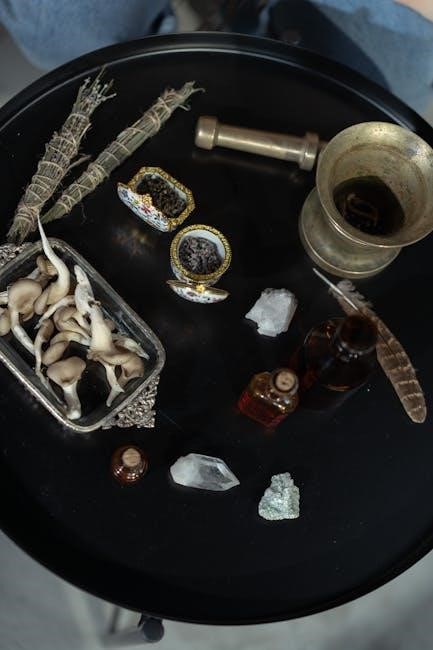
The cultivation of psilocybin mushrooms involves several key steps, starting with substrate preparation and sterilization. Once the substrate is inoculated with mycelium, it colonizes, forming a nutrient-rich base. After colonization, the environment is adjusted to induce fruiting, where mushrooms develop. Maintaining optimal humidity, temperature, and airflow is crucial during this phase. Proper care ensures a healthy harvest, while contamination prevention and timely intervention are essential for a successful grow.
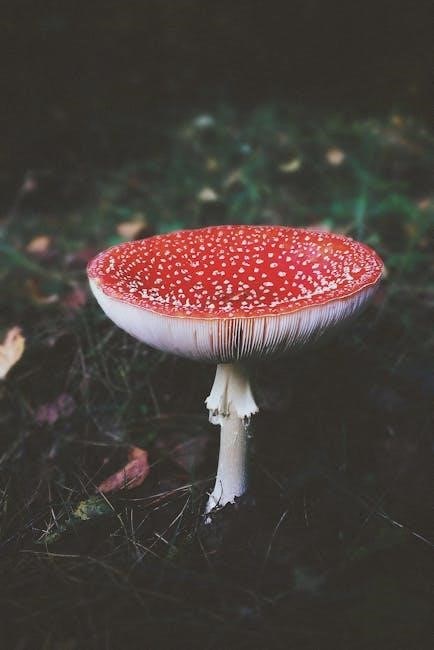
Understanding Psilocybin Mushroom Biology
Psilocybin mushrooms exhibit a fascinating life cycle, involving mycelium growth and fruiting. Understanding their biology is key to successful cultivation and appreciating their ecological role.
2.1 Structure and Life Cycle of Psilocybin Mushrooms
Psilocybin mushrooms, like most fungi, have a life cycle divided into two main stages: the vegetative phase, where mycelium spreads, and the reproductive phase, producing fruiting bodies. The mycelium grows by breaking down organic matter, forming a network of hyphae. Once conditions are optimal, the mycelium transitions to producing mushrooms, which disperse spores for propagation. This cycle is essential for understanding cultivation dynamics and ensuring successful growth.
2.2 Role of Mycelium in Mushroom Growth
Mycelium is the vegetative part of the fungus, consisting of a network of branching hyphae. It plays a crucial role in decomposing organic matter and absorbing nutrients, which are essential for mushroom growth. The mycelium colonizes the substrate, breaking it down into simpler compounds that fuel the development of fruiting bodies. Healthy mycelium is vital for a successful harvest, as it directly impacts the size, quantity, and quality of the mushrooms that grow.
Preparing the Substrate
Preparing the substrate involves mixing materials like vermiculite, brown rice flour, and water, followed by sterilization or pasteurization to eliminate contaminants and create a nutrient-rich environment for mycelium growth.
3.1 Materials Needed for Substrate Preparation
Key materials for substrate preparation include vermiculite, brown rice flour, and water. Vermiculite aids moisture retention, while brown rice flour provides nutrients. Optional additives like gypsum or oyster shells enhance structure. A clean workspace, measuring cup, mixing bowl, and sealed container are essential. Proper sterilization ensures contaminant-free growth. These components create a nutrient-rich base for mycelium colonization, a critical step in successful mushroom cultivation.
3.2 Sterilization and Pasteurization Techniques
Sterilization and pasteurization are critical to prevent contamination. Autoclaving at 15 PSI for 60 minutes ensures complete sterilization, while pasteurization at 140°F–160°F for 1–2 hours targets harmful microbes. Chemical sterilization with hydrogen peroxide is an alternative. These methods ensure a clean substrate for mycelium growth, reducing contamination risks and promoting healthy colonization. Proper sterilization is essential for a successful psilocybin mushroom cultivation process.
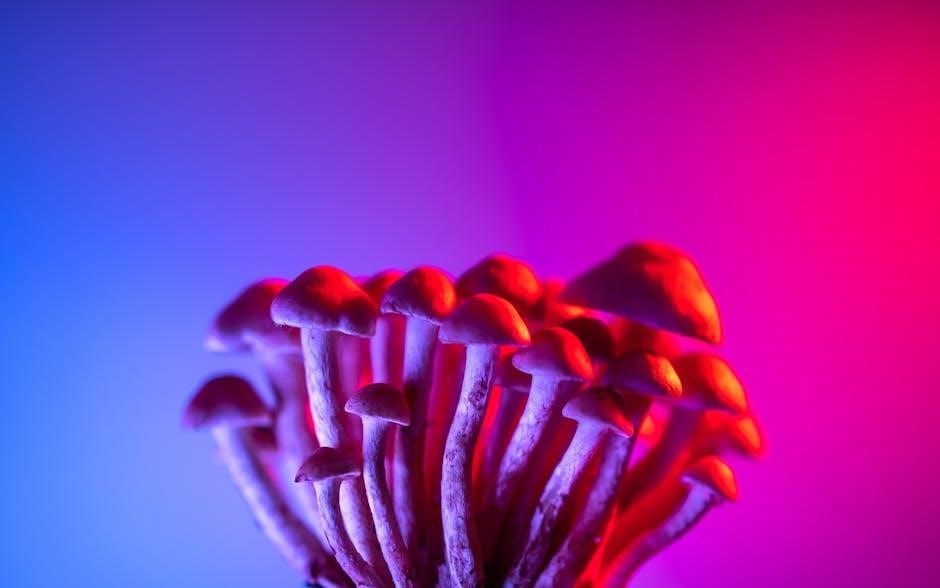
Choosing the Right Psilocybin Mushroom Species

Choosing the right psilocybin mushroom species is essential for successful cultivation. Different species thrive in various environments and have unique growth habits. Understanding their specific needs ensures optimal results. This guide helps you select varieties suited to your setup, considering factors like climate, substrate preferences, and desired potency levels.
4.1 Popular Species for Home Cultivation
Psilocybe cubensis is the most popular species for home cultivation due to its ease of growth and abundant flushes. B+ and Golden Teacher strains are favorites among hobbyists for their resilience and consistent results. Other notable species include P. azurescens and P. semilanceata, though they require more specific conditions. Choosing the right species depends on your climate, substrate, and desired potency, ensuring a successful and rewarding growing experience.

4.2 Characteristics of Psilocybe Cubensis
Psilocybe cubensis is one of the most popular psilocybin mushroom species for home cultivation due to its adaptability and resilience. It thrives on various substrates, including straw and compost, and has a relatively short growth cycle. The mushrooms typically feature medium to large caps with a convex to umbonate shape and a light to golden brown color. Their ability to grow in diverse conditions makes them a favorite among cultivators, ensuring consistent and bountiful flushes for both novices and experienced growers alike.
Setting Up the Growing Environment
Creating an optimal grow room involves maintaining precise humidity and temperature levels to ensure healthy mycelium growth and robust mushroom development. A clean, controlled environment is essential for successful cultivation.
5.1 Creating an Optimal Grow Room
A well-designed grow room is crucial for successful psilocybin mushroom cultivation. Maintain consistent humidity (70-80%) and temperature (70-75°F) to mimic natural environments. Ensure proper airflow using HEPA filters to prevent contamination. Provide indirect light to promote healthy mycelium growth. A clean, sterile space with minimal disturbances will foster optimal conditions for your mushrooms to thrive, ensuring a robust and healthy harvest.
5.2 Maintaining Humidity and Temperature
Maintaining consistent humidity (70-80%) and temperature (70-75°F) is vital for healthy mycelium growth and fruiting. High humidity prevents substrate drying, while stable temperatures promote optimal conditions. Use a hygrometer and thermometer to monitor levels. Employ a humidifier or misting schedule to maintain humidity, and ensure good airflow to prevent overheating. Consistent environmental control is key to fostering robust mushroom development and minimizing contamination risks.

Managing Contamination and Pests
Contamination and pests can severely impact mushroom growth. Regular monitoring, clean environments, and proper sterilization techniques are essential to prevent infestations and maintain healthy cultivation conditions.
6.1 Common Contaminants in Mushroom Cultivation
Common contaminants in mushroom cultivation include mold, bacteria, and pests like mites or flies. Mold, such as green mold or black mold, can rapidly colonize substrates, while bacteria compete for nutrients. Pests are attracted to the moisture and organic matter, laying eggs that hatch into larvae. These contaminants can devastate a crop if not addressed promptly through sterilization and hygiene practices.
6.2 Preventative Measures and Solutions

Prevent contamination by maintaining a clean grow environment, using sterile equipment, and adhering to proper pasteurization techniques. Regularly inspect substrates and mushroom pins for signs of mold or pests. Implementing HEPA air filtration and using gloves during handling can minimize contamination risks. Promptly removing infected areas and ensuring proper humidity levels are crucial for a healthy grow. Act quickly to prevent outbreaks and protect your crop.
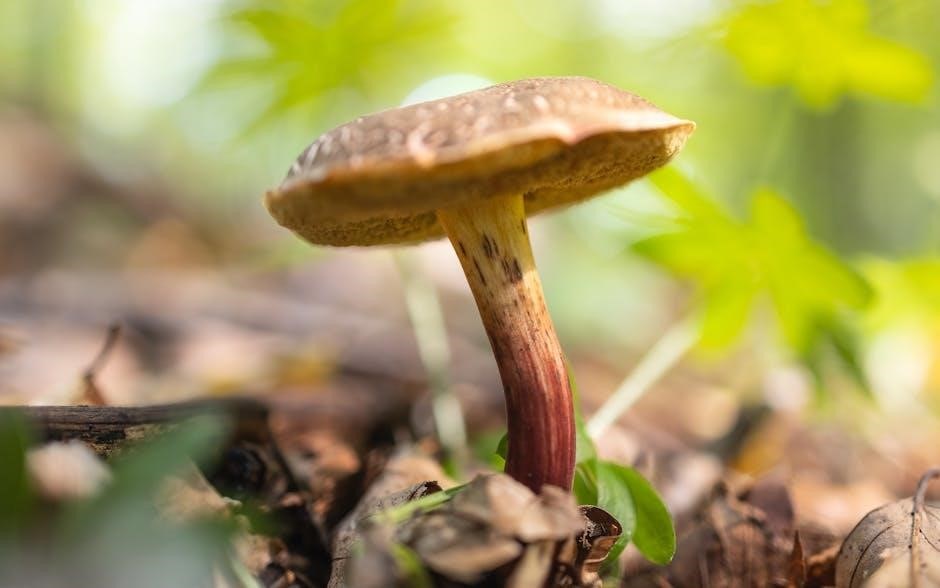
Harvesting Your Mushrooms
Harvest mushrooms when caps fully open. Twist gently to avoid damaging mycelium. Clean substrate post-harvest to encourage a healthy second flush and optimize yields.
7.1 When and How to Harvest Mushrooms
Mushrooms are ready to harvest when caps fully open and slightly curl up. Gently twist the stem at the base to avoid damaging the mycelium. Use clean tools like a knife or scissors for precise removal. Harvesting promotes a clean environment for the second flush. Proper timing ensures maximum potency and minimizes contamination risks, optimizing the overall yield and quality of your grow.
7.2 Handling the Second Flush
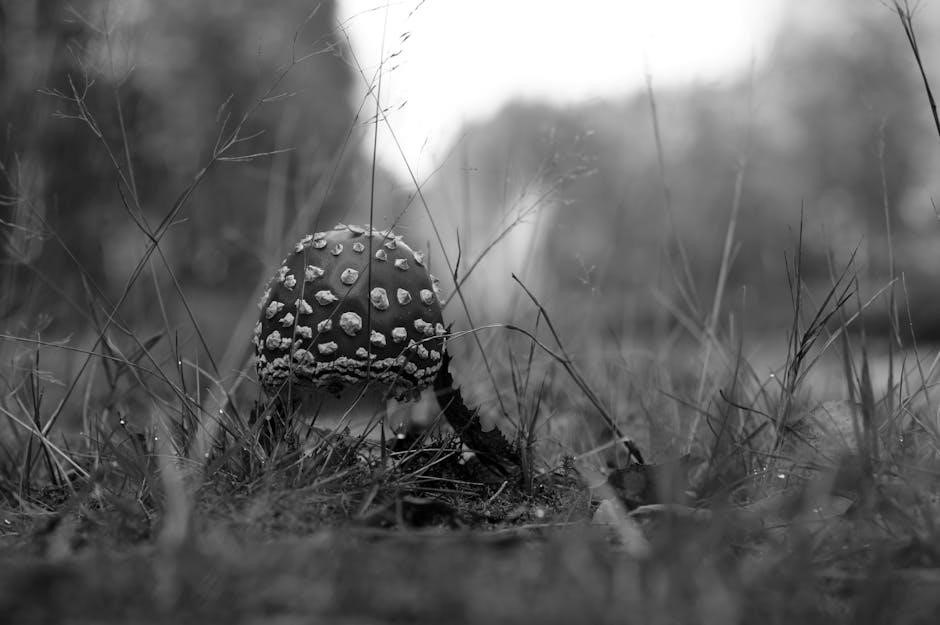
A second flush occurs when the mycelium produces additional mushrooms after the first harvest. Maintain a clean environment, ensure proper humidity, and monitor temperature to encourage healthy regrowth. Inspect the substrate regularly for new pins, as they typically appear within a week or two. Harvest these as you would the first flush to maximize yield and quality. Proper handling ensures a bountiful and successful grow cycle.
Cultivating psilocybin mushrooms requires patience, attention to detail, and dedication. By following proper techniques and maintaining a clean environment, you can achieve a successful and rewarding grow experience.
8.1 Summary of Key Takeaways
Successful psilocybin mushroom cultivation hinges on meticulous substrate preparation, sterilization, and maintaining optimal environmental conditions. Selecting the right species, like Psilocybe cubensis, ensures ease of growth. Consistent humidity and temperature control are crucial for healthy mycelium development. Regular monitoring and prompt action against contamination are essential to maximize yields. Patience and adherence to proven methods will lead to a bountiful harvest and a fulfilling experience.
8.2 Encouragement for Further Exploration
Embrace the fascinating world of psilocybin mushroom cultivation with curiosity and enthusiasm. Continue exploring resources, joining communities, and experimenting with new techniques to refine your skills. The journey of mycology is lifelong, offering endless opportunities for growth and discovery. Stay open to learning, share knowledge, and contribute to the evolving understanding of these remarkable organisms. Happy growing!
Additional Resources
Explore Psilocybin Mushroom Growers Guide and The Psilocybin Mushroom Bible for in-depth knowledge. Join online forums and communities for shared experiences and reliable supplier information.
9.1 Recommended Reading and Guides
For a comprehensive understanding, we recommend Psilocybin Mushroom Growers Guide for its detailed step-by-step instructions and The Psilocybin Mushroom Bible for its scientific insights. Mushrooms Demystified offers a thorough guide to various species. These books are available on major online retailers and provide essential knowledge for successful cultivation. They are invaluable resources for both beginners and experienced growers.
9.2 Online Communities and Forums
Engage with online communities like Shroomery and Reddit’s r/mushroomcultivation for valuable insights and support. These forums offer practical advice, troubleshooting tips, and shared experiences from seasoned growers. They are excellent resources for addressing specific challenges and staying updated on best practices. Participating in these communities can enhance your learning and provide a network for exchanging knowledge and ideas.

